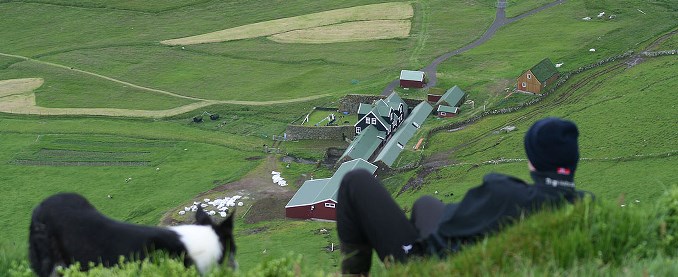
The Faroe Islands: High drama in the North Atlantic
Stranded between Iceland and Norway, these tiny islands are the perfect escape
It was not until I got back to the top and stood looking down, alongside a trio of unconcerned puffins, that I fully realised what I'd just done. I had climbed down and back up an almost vertical 150m sea cliff, a vertiginous route of rough paths, ropes, ladders and a precipitous grassy slope made manageable only by stepping in old puffin burrows. It used to be the only way on to this island – and then only if the unpredictable North Atlantic would allow a boat into the narrow rocky inlet below. For someone who doesn't like heights, it was an achievement.
Today, access to the smallest inhabited Faroe Island is exclusively by helicopter. The 20-minute flight from the tiny coastal heliport in the capital Torshavn (subsidised by the government, so costing under £15) is a treat in itself.
The archipelago is impressively isolated, caught midway between Norway and Iceland, yet under Danish rule. As we rose into the air, the turf-roofed ochre-red buildings of Tinganes, the old Danish trading centre and first location of the Viking "Thing" (the parliament – still in operation) grew smaller and smaller until they gave way to a map-like scene of green islands and blue sea. Tiny settlements of brightly coloured houses and whitewashed churches huddled between the mountains, looking impossibly cut off. But even those communities regard my final destination as remote.
As we approached, Stora Dimun looked uninhabitable. Its treeless top – just two-and-a-half square kilometres in extent – was surrounded by sea cliffs up to 400m high. It was beautiful, but daunting.
As we flew along the cliffs, a narrow stretch of lower ground came into view, with a few buildings and a helipad. I was received – along with the supermarket shopping – by Eva Ur Dimun (the family is named after the island), the charming English-speaking farmer and mother of two young children, whose family has farmed this island for eight generations.
My temporary home had a traditional turf-roofed and black-tarred exterior, but was modern, warm and comfortable inside. The family had only recently finished building it. They'd done it by hand – with all the raw materials flown in by helicopter – to house their children's teacher during term-time and paying guests in the holidays.
This is the ultimate get-away-from-it-all destination. The air in the Faroes is incredibly fresh, its cleanliness borne out by the profusion of orchids (wherever the sheep can't get to) and lichen-covered rocks. "The Road" on Dimun is a zig-zag path up the steep grassy slope towards the top of the island. Here you can almost smell the freshness as great skuas circle overhead, snipe rise from their nests and shaggy Faroese sheep observe the scene dispassionately. On a clear day you have a stunning aerial panorama – as good as the helicopter and much more peaceful.
The cliffs – viewed from outcrops above or close-up from the base of the cliff path – are home to hordes of nesting seabirds: kittiwakes, guillemot, puffins and more.
The sound they make is extraordinary. However, these days, the family told me, the noise is nothing compared to what it used to be: seabird numbers are rapidly diminishing in the archipelago. The only benefit from this decline is that men no longer die clambering down the cliffs on ropes to collect the birds' eggs. Eva's grandfather, a twinkling character, who at 88 still strides the island's slopes, is the first Dimun farmer to survive into old age.
Later, I was invited to join the family for dinner and eat some of the lamb from which they now make most of their living. It was utterly delicious – though I have to admit the dried version was stronger than I could take. The kitchen was modern, with just a few telltale signs that this is not Copenhagen or Stockholm, particularly the drying sheep's bladders that were hanging from the ceiling, which are used as children's balls and popped at New Year.
As we sat chatting, a starling flew in, followed by the eight-year-old daughter of the house. Dogg (meaning dew) introduced us to her pet, which perched first on her head and then on mine. The bird flies free each day but always returns. Such pets are one of the benefits of their unusual lifestyle, said Eva. The family's lives are tied very closely to nature, yet they are also only rarely far from their house.
Eva's husband Jogvan Jon then looked at his watch and leapt up: he was late for milking the cow. Gerda had to be rounded up from wherever she was on the island before we met in the tiny cowshed next door and I "helped" – definitely in inverted commas. In the end, though, a large bucket of foaming milk was carried back to the kitchen, with some of it poured straight into our after-dinner coffee.
I noticed that Eva sported a covetable Sarah Lund-style jumper. Those worn by The Killing's detective, like Eva's, come from Torshavn, and seem to be day-to-day wear for the Faroese. Eva also showed me their national dress, still worn for special occasions: her son Sproti's silver-buttoned blue jacket and embroidered red shirt, and her own full skirt, laced top and shawl. In the Faroes, tradition is not for tourists, it is lived.
There is a saying in these islands: "If you don't like the weather, wait five minutes." The sun was shining as I gathered up my belongings on the last day of my visit – but I found myself hoping that the clouds might descend so that the helicopter would have to leave us here a while longer
« Aftur / Back


